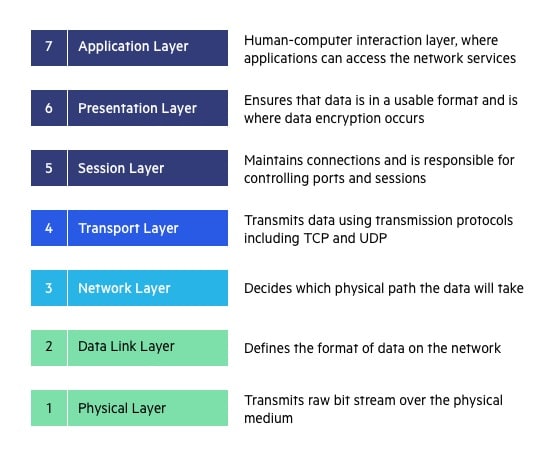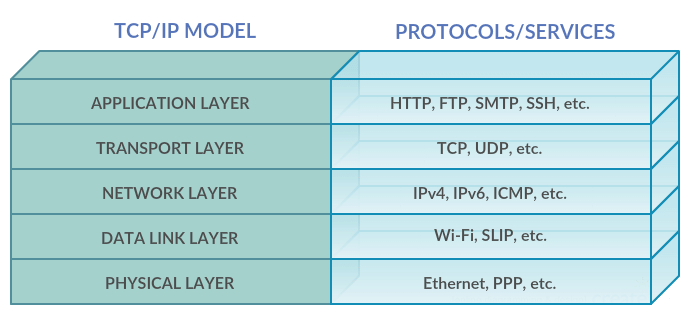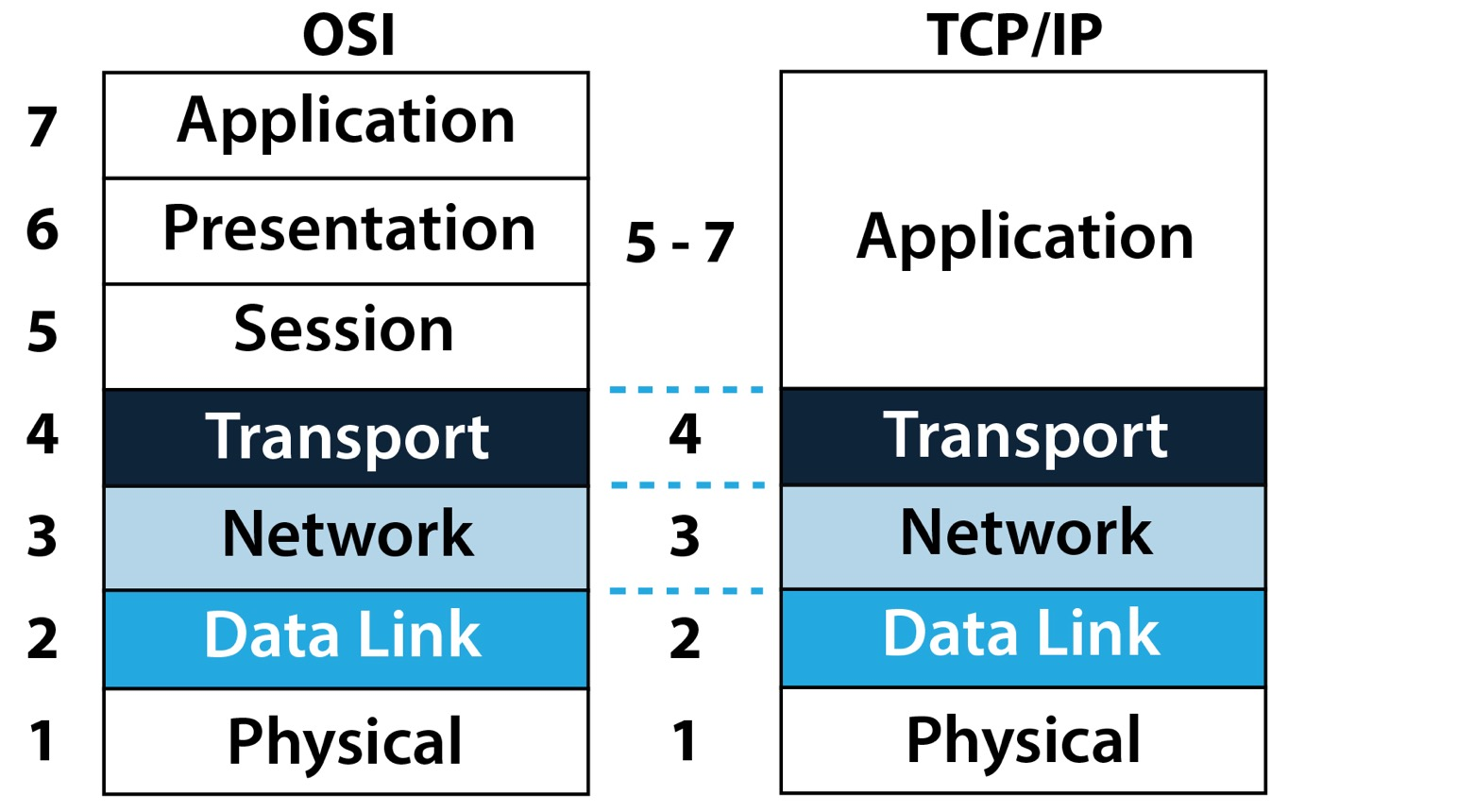Comparing the Building Blocks: OSI Model vs. TCP/IP Model
Introduction
Networking – a skill that resonates loudly in the realm of technical IT roles. It’s a non-negotiable proficiency for anyone navigating the intricate landscapes of information technology. At the heart of this expertise are two pivotal models: the Open Systems Interconnection (OSI) model and the Transmission Control Protocol/Internet Protocol (TCP/IP) model. Serving as foundational blueprints, these models play a crucial role in designing, implementing, and troubleshooting networks. They offer a conceptual framework that streamlines communication between devices. This blog post aims to dissect both models, exploring their different layers.
OSI Model

The Open Systems Interconnection (OSI) model stands as a foundational framework for understanding and conceptualizing network communication. Introduced by the International Organization for Standardization (ISO), the OSI model is structured into seven distinct layers, each serving a specific purpose in the transmission of data.
- Physical Layer
At the base of the OSI model lies the Physical Layer, where the tangible elements of network communication come into play. Cables, connectors, and hardware components are the focus here, determining how bits are transmitted over various media.
- Data Link Layer
Moving up, the Data Link Layer provides a mechanism for error detection and correction within the physical layer. This layer is responsible for organizing bits into frames and ensuring reliable point-to-point communication between devices on the same network. Here you will find protocols and technologies such as Ethernet, MAC/LLC, VLAN etc.
- Network Layer
The Network Layer introduces the concept of logical addressing, such as IP addresses. It manages the routing of data packets between devices on different networks, enabling communication across diverse systems. Devices on this layer use Internet Protocol (IP), Internet Protocol Security (IPsec) and more.
- Transport Layer
The Transport Layer ensures end-to-end communication reliability. It segments and reassembles data into manageable chunks, addressing issues such as flow control, error recovery, and acknowledgment of received data. Protocols at this layer are responsible for moving data between devices. The most common protocols here are Transmission Control Protocol (TCP) and User Datagram Protocol (UDP).
- Session Layer
To establish communication between two devices, an application must initiate a session, a unique entity linked to the user and identifier on the remote server.
The duration of the session must be long enough to allow data transfer, but it must be closed once the transfer is complete. When large volumes of data are being transferred, the session is responsible for ensuring that the file is transferred in its entirety, and for re-establishing transmission in the event of incomplete data.
For example, if 10 MB of data are being transferred and only 5 MB are complete, the session layer ensures that only the complete 5 MB are retransmitted. This approach to transfer optimizes communication efficiency on the network, avoiding wasted resources and limiting retransmission to the necessary part of the file.
- Presentation Layer
The presentation layer prepares data for display. Two different applications often use different encodings.
For example, when communicating with a web server via HTTPS, information is encrypted. The presentation layer is responsible for encoding and decoding the information so that it can be read. In addition, the presentation layer handles the compression and decompression of data as it is transferred from one device to another.
- Application Layer
At the top of the OSI model is the Application Layer, the interface between the network and the user. This layer facilitates communication between software applications, allowing users to interact with network services. Most people are familiar with some technologies of this layer such as Hypertext Transfer Protocol (HTTP), Simple Mail Transfer Protocol (SMTP) and The Domain Name System (DNS).
One of the distinctive features of the OSI model is its hierarchical nature. Each layer builds upon the functionalities of the layers beneath it, creating a structured and modular approach to network design. This organization allows for flexibility and scalability, making it a valuable reference for network architects and administrators. The OSI model provides a universal structure for understanding and building network communication systems, independent of specific protocols or technologies.
TCP/IP Model

While the OSI model provides a comprehensive framework for understanding networking, the Transmission Control Protocol/Internet Protocol (TCP/IP) model has emerged as the de facto standard for the design and implementation of the internet. Originating from the development of the ARPANET, the TCP/IP model is renowned for its simplicity and effectiveness. Unlike the OSI model’s seven layers, the TCP/IP model condenses the network communication process into five layers, offering a streamlined and practical approach.
- Physical Layer
In the TCP/IP model, the Physical Layer encompasses the same functions as the corresponding layer in the OSI model. It deals with the physical connection between devices, specifying details such as cable types, connectors, and hardware interfaces.
- Data Link Layer
The TCP/IP Data Link Layer ensures error-free communication between devices on the same local network, using protocols like Ethernet, MAC, and LLC. It plays a crucial role in framing data, detecting errors, and managing device addressing for efficient local network communication.
- Network Layer
Similar to the OSI model, the TCP/IP model’s Network Layer handles logical addressing and routing. Here, the Internet Protocol (IP) comes into play, managing the delivery of data packets across different networks.
- Transport Layer
The Transport Layer in the TCP/IP model closely resembles its counterpart in the OSI model. It is responsible for end-to-end communication and ensures the reliable and orderly delivery of data between devices. The Transmission Control Protocol (TCP) and User Datagram Protocol (UDP) operate at this layer.
- Application Layer
At the top of the TCP/IP model is the Application Layer, encompassing functionalities from the OSI model’s top three layers (Session, Presentation and Application). This layer serves as the interface between network services and end-user applications, handling communication between software and the lower layers.
One of the key strengths of the TCP/IP model lies in its practicality and simplicity. By consolidating the OSI model’s seven layers into five, the TCP/IP model streamlines the networking architecture, making it more intuitive for real-world implementation. This adaptability has contributed to the widespread adoption of the TCP/IP model as the foundation of the modern internet.
OSI vs. TCP/IP

OSI
The OSI model, with its detailed layering, proves invaluable in the initial stages of network design. Architects can use this model as a blueprint to organize and structure the various components of a network. Moreover, the OSI model is designed to be protocol-independent, meaning it can be applied to any network technology.
The OSI model is widely utilized in educational settings to teach the fundamentals of networking. Its seven layers provide a comprehensive framework for students to grasp the intricacies of network communication. However, its theoretical nature can be perceived as complex in real-world applications.
One of the key strengths of the OSI model lies in its ability to compartmentalize network functionality into distinct layers. When troubleshooting, this layering proves invaluable. By isolating problems to specific layers, IT professionals can pinpoint the source of issues more efficiently. For example, problems at the Data Link Layer may involve hardware or cabling, while issues at the Transport Layer could relate to protocol or configuration errors.
TCP/IP
The TCP/IP model is the backbone of the internet. Its streamlined structure, comprising five layers, aligns seamlessly with the protocols governing internet communication.
Known for its simplicity, the TCP/IP model is favored for real-world implementation. It offers a practical and straightforward approach to networking, making it suitable for a wide range of applications. Its adaptability has led to its widespread adoption in various networking environments.
The TCP/IP model is based on specific protocols like TCP and IP, which are dominant in the internet. However, because the model combines many functions in the application layer, troubleshooting at this level might be difficult. If someone thinks that there is an issue at this level it might require some digging because it encapsulates many different protocols and functionalities.
Conclusion
Both the OSI and TCP/IP models have applications in network design, troubleshooting, and real-world implementation. The OSI model’s layering proves advantageous in educational contexts, while the TCP/IP model’s simplicity shines in practical, real-world environments. Each model brings its own set of strengths to the table, and professionals must carefully consider the context, requirements, and goals of their networking endeavors.
As we only scratched the surface of each model and their different layers, I encourage you to continue exploring the dynamic field of networking especially if you aspire to be in a networking role. My go-to resources to refresh and deepen my networking skills are The TCP/IP Guide: A Comprehensive, Illustrated Internet Protocols Reference and Attacking Network Protocols: A Hacker’s Guide to Capture, Analysis, and Exploitation .
Thank you for joining me on this educational journey. If you have further questions or if there are specific topics you’d like me to cover in the future, feel free to reach out. Until then, keep learning!